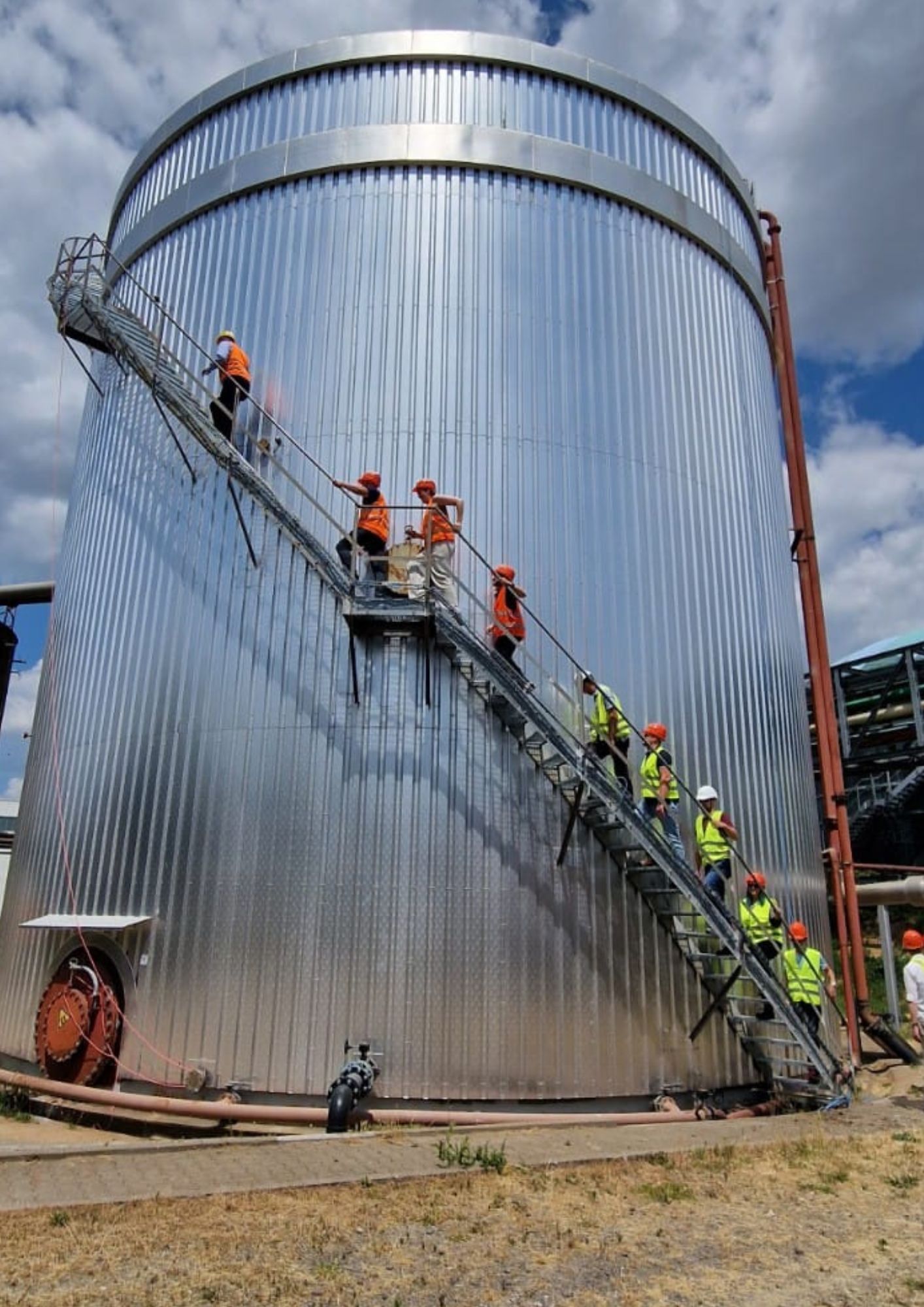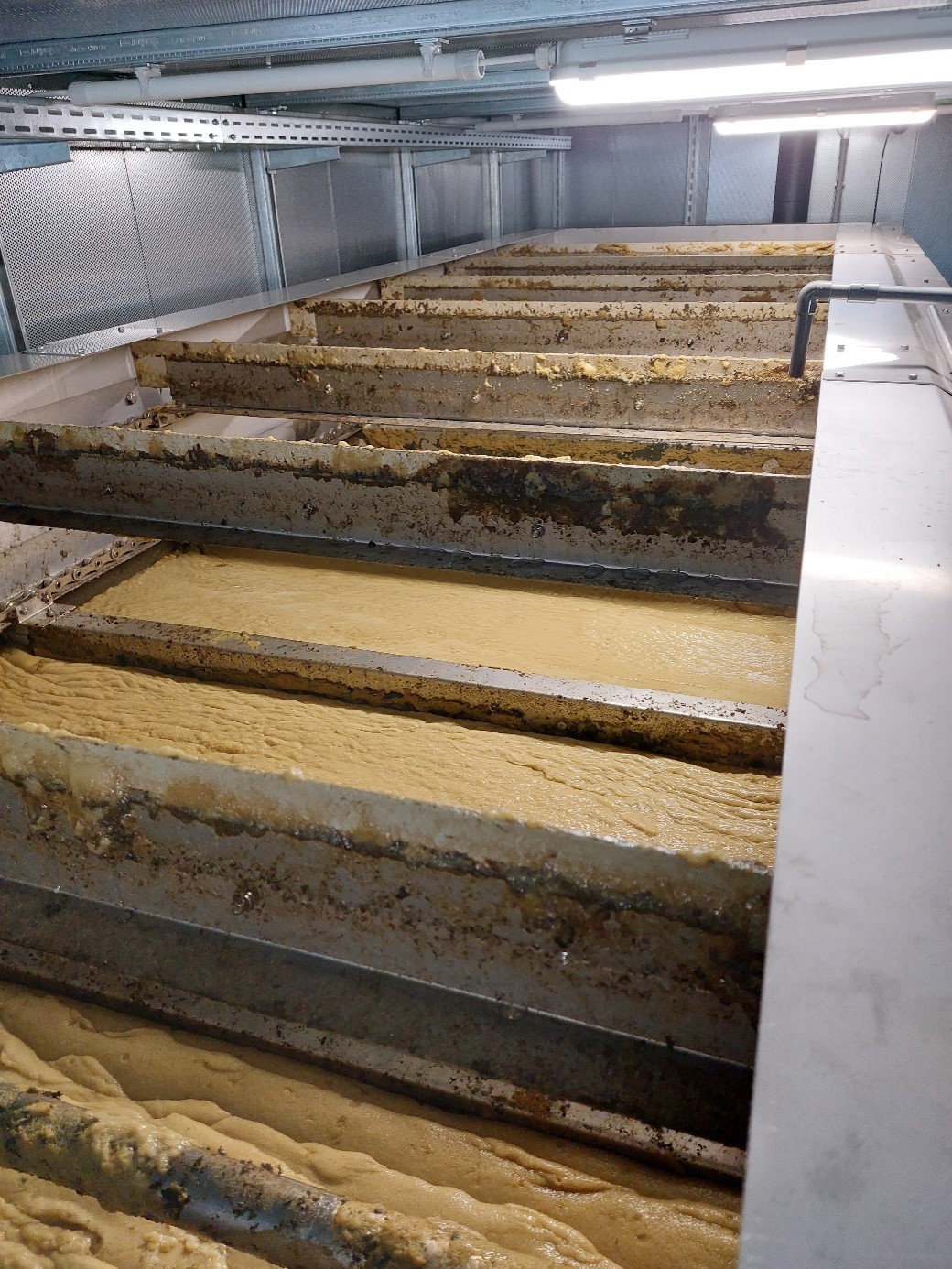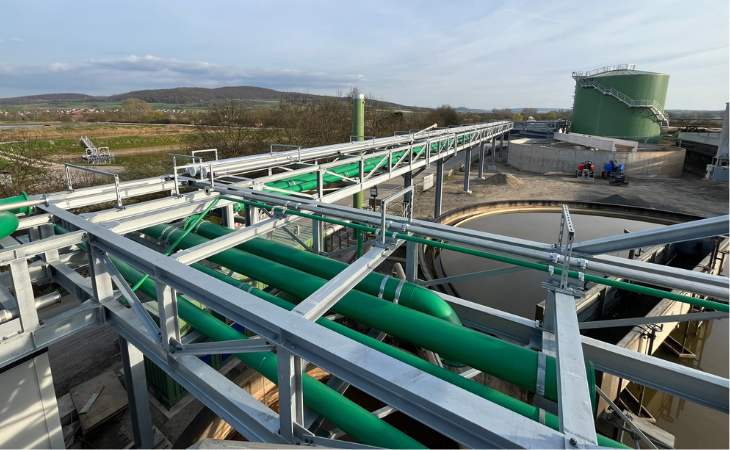The production of biogas from wastewater is an efficient and sustainable process that is becoming increasingly important in industrial wastewater treatment. Particularly in the food industry, dairies, the sugar industry and in the treatment of flotate sludge, biogas production offers an excellent opportunity to recycle organic waste and at the same time generate energy in the form of methane.
Table of contents
Technical background: Biogas from wastewater
The anaerobic digestion of wastewater and sludge is the main process by which biogas is produced. Wastewater from food processing is particularly rich in organic substances such as fats, proteins and carbohydrates, which are ideal substrates for anaerobic microorganisms. Under anaerobic conditions (i.e. without oxygen), the microorganisms decompose these organic substances, producing mainly methane (CH₄) and carbon dioxide (CO₂). The methane fraction of the biogas produced can be used to generate electricity and heat.
Biogas is produced in four stages:
Hydrolysis: Macromolecular compounds such as carbohydrates, fats and proteins are broken down by microorganisms into smaller molecules such as sugars, fatty acids and amino acids.
Acidogenesis: In this phase, the substances produced by hydrolysis are further broken down by microorganisms into volatile fatty acids, alcohols, hydrogen and carbon dioxide.
Acetogenesis: Volatile fatty acids and alcohols are converted to acetic acid, carbon dioxide and hydrogen.
Methanogenesis: In this final phase, methane is produced by methane bacteria from acetic acid, carbon dioxide and hydrogen. The largest proportion of biogas consists of methane (approx. 50-75 %) and carbon dioxide (approx. 25-50 %).
Wastewater from the food industry
The food industry produces large quantities of organically contaminated wastewater, particularly from the processing of fats, proteins and carbohydrates. Typical sources of wastewater are
Dairies: Waste water from milk processing, such as whey, contains high concentrations of lactose (milk sugar) and fat, which can be converted into biogas during anaerobic fermentation.
Sugar industry: The sugar industry, in particular the processing of sugar beet, produces wastewater with a high organic content. This contains carbohydrates (sugar residues) and plant matter, which are ideal substrates for biogas production.
Meat processing industry: Meat processing and abattoirs produce wastewater with a high fat and protein content, which can also be used as a raw material for biogas production.
Beverage and brewing industry: The beverage industry, especially breweries, produces organically contaminated wastewater containing high amounts of organic acids and carbohydrates.

Photo: ALMA BHU GMR biogas plant for the sugar industry
Flotation sludge
Flotate sludge is a typical by-product of the physical-chemical pre-treatment of industrial wastewater, especially in food processing. They are produced by the flotation processin which fats, oils and particles containing solids are removed from the wastewater. These flotate sludges are heavily loaded with organic material and offer a high potential for biogas production.
As flotate sludge often contains a high concentration of fats and oils, it is particularly suitable for methane production, as fats have a very high energy density and produce more biogas per unit mass during fermentation than other organic substances.

Photo: Flotate sludge with a high organic load. The flotate sludge can be utilized in biogas plants(ALMA NeoDAF flotation plant)
Process for biogas production from wastewater
Biogas is typically produced from industrial wastewater in digesters or anaerobic reactors. anaerobic reactors. The wastewater or sludge is collected in a sealed tank where the anaerobic microorganisms break down the organic substances. This process involves several phases:
Pre-treatment of the wastewater: Before fermentation, the wastewater usually has to be pre-treated in order to remove large particles and undissolved substances. This is often done by mechanical filtration or flotation.
Anaerobic digestion: In an anaerobic reactor, bacteria decompose the organic material in the absence of oxygen. This process takes place in several steps: First, the complex organic substances are broken down into smaller components by hydrolytic bacteria, which are then converted into volatile fatty acids by acidogenic bacteria. Finally, methanogenic bacteria convert the fatty acids into methane and carbon dioxide.
Biogas utilization: The biogas produced is generally used in combined heat and power plants (CHP) to generate electrical energy and heat, which can be used to operate the plant itself or to cover the energy requirements of the production plant.

Photo: ALMA BHU GMR biogas plant with post-treatment and biomass recirculation
Advantages of biogas production from wastewater
Energy generation: The fermentation of organically contaminated wastewater not only purifies the wastewater, but also produces biogas that can be used to generate electricity and heat. This helps to reduce energy costs and increases the energy efficiency of the plant.
Waste reduction: Anaerobic digestion reduces the amount of sludge that needs to be disposed of, as a large proportion of the organic matter is converted into biogas. This leads to a reduction in the cost of disposing of sewage sludge or flotation sludge.
Sustainability: The production of biogas from wastewater contributes to the circular economy as organic waste is recycled and converted into renewable energy. This helps companies to improve their carbon footprint and reduce their environmental impact.
Reduction of greenhouse gas emissions: Anaerobic digestion allows methane, which would otherwise be released into the atmosphere during the natural decomposition of organic material, to be controlled and used for energy. This helps to reduce greenhouse gas emissions.
Challenges
Complexity of the substrate: Wastewater from the food industry often contains fatty or protein-rich substrates that require special bacterial cultures and adapted reactors to ensure effective biogas production.
Gas treatment: In addition to methane, biogas also contains hydrogen sulphide (H₂S) and other impurities that must be removed before use. This requires additional treatment technologies.
Conclusion
The production of biogas from wastewaterespecially from the food industry, dairies, the sugar industry and flotation sludge, is an ecologically and economically viable method of converting organic residues into renewable energy. By using anaerobic reactors, wastewater costs can be reduced as well as energy costs, while at the same time reducing the company's carbon footprint.
For further information on our products, please feel free to contact us at any time!







